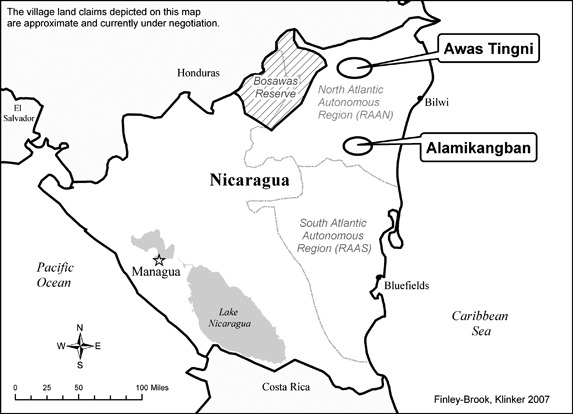T he Bosawas Reserve was established in 1997 in the northern part of Jinotega, which borders with Honduras. The Bosawas Reserve covers land that is traditionally inhabitted by the Sumo and Miskito indigenous peoples. The reserve is a UNESCO (United Nations Educational, Scientific and Cultural Organization) biosphere reserve. It is the second largest forest in the world, right behind the Amazon in Brazil.
he Bosawas Reserve was established in 1997 in the northern part of Jinotega, which borders with Honduras. The Bosawas Reserve covers land that is traditionally inhabitted by the Sumo and Miskito indigenous peoples. The reserve is a UNESCO (United Nations Educational, Scientific and Cultural Organization) biosphere reserve. It is the second largest forest in the world, right behind the Amazon in Brazil.
The Bosawas Reserve was established as a protected forest by the Nicaraguan Institute for the Environment. The decision to create the protected forest, however, has raised many questions regarding indeginous land rights and the colonial attitudes underlying the creation of protected forests. In the process of designating Bosawas as a protected forests, the people who lived on the land, particularly Sumo and Miskito, were effectively excluded from the conservation. Many feel that their land rights were violated, and that the promise to maintain the region governmentally autonomous under the Sandanista revolution was abandoned.
the promise to maintain the region governmentally autonomous under the Sandanista revolution was abandoned.
In 2000, conflicts rose between the government and the inhabitants in Bosawas, who accused the Institute for Agrarian Reform of selling land to people for commerical farming.
Currently, the Bosawas Reserve is a huge tourist attraction that boasts its extensive wildlife and "unexplored" land. Tourists are required to register before visiting the reserve and are required to pay a guide to trek through the forest. However, it is unclear how the indigenous inhabitants of the Bosawas benefit economically from the tourist activity in the area. The topic of environmental conservation worldwide has brought about questions of the beneficiaries of protected forest. From Asia to Africa and Latin America, it has become apparent that the establishment of protected forests have been used as a way to extend colonial-like power over indigenous people and their access to land and its resources. The income from tourism in the region has contributed very little to the indigenous communities in Bosawas. As the state exerts it control over the protected forests, it denies the inhabitants land rights while profiting from the forest.
More alarmingly, settlers from the north have identified economic opportunities in the forests, and more people have been moving into the reserve unauthorized.  Settlers caused significant deforestation due to extensive commercial agriculture and cattle herding. Given their unclear land rights, the Sumo and Miskito inhabitants have found it difficult to stop the constant influx of immigrants into the reserve. Leaders of indigenous tribes in Bosawas have travelled to Managua in order to gain state support in stopping the deforestation due to unauthorized settlers in the land. The loss of wildlife and water ways are an immediate threat with continued deforestation in the area, and it is one of the biggest environmental concerns facing Nicaragua today.
Settlers caused significant deforestation due to extensive commercial agriculture and cattle herding. Given their unclear land rights, the Sumo and Miskito inhabitants have found it difficult to stop the constant influx of immigrants into the reserve. Leaders of indigenous tribes in Bosawas have travelled to Managua in order to gain state support in stopping the deforestation due to unauthorized settlers in the land. The loss of wildlife and water ways are an immediate threat with continued deforestation in the area, and it is one of the biggest environmental concerns facing Nicaragua today.
The state's cooperation with the inhabitants of the Bosawas Reserve will ultimately lead to progress in environmental conservation in the area, and handing over land rights to indigenous people will allow them to dictate the immigration and conservation measures they see necessary. Furthermore, it will help the economic viability of the protected forest and help indigenous communities as well. If the reserve is to survive, including the Sumo and Miskito is essential.